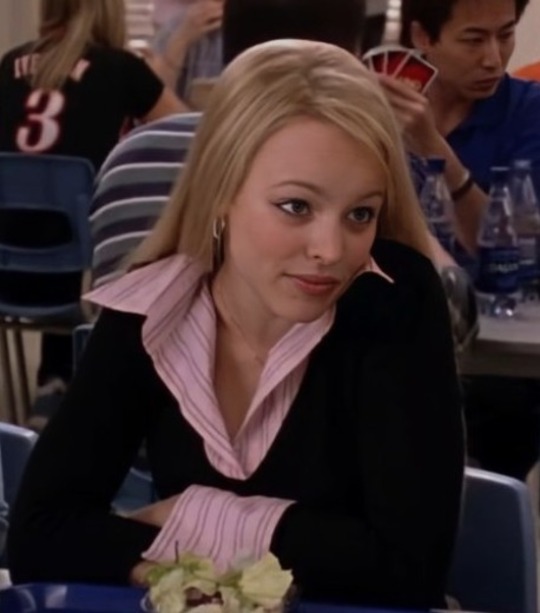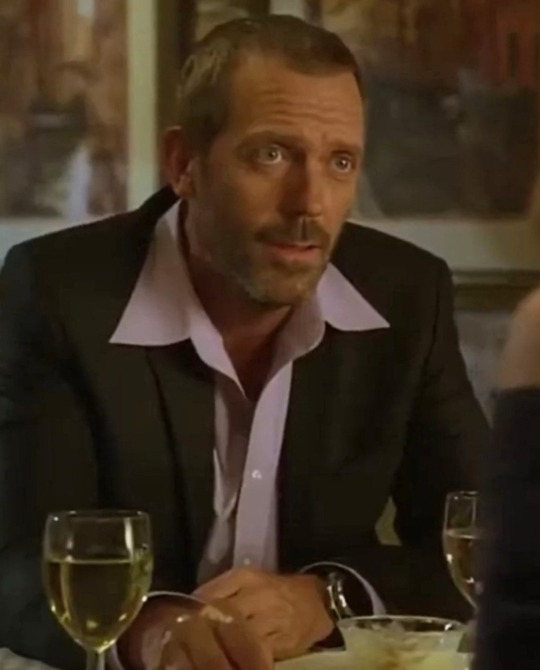Text
Les Mis Canon-era Paris Photographs: Jean Valjean and Cosette’s route to escape Javert, in Pictures!

Jean Valjean's escape through Paris is Victor Hugo's way of mourning the Paris he knew from before his exile, the Paris before the modern renovations.
Hugo wrote Les Mis from exile in Guernsey, at the same time as Paris was undergoing a series of massive renovations. The "Old City" of medieval Paris that Hugo loved was being replaced by the “New City" of Baron Haussman. The dark medieval labyrinth lit by oil lamps was being replaced by modern wide streets and standardized architecture lit by gas lamps. Victor Hugo is nostalgic for the Paris he remembers before his exile-- so Jean Valjean is able to escape Javert using things unique to the Old City. He escapes through a labyrinth of tiny medieval streets in a neighborhood Hugo claims was destroyed during the renovations; he climbs over the convent wall using the rope from an oil lamp, the very oil lamps that were being replaced by the more modern gas lanterns. The dark maze hides him from police surveillance in a way modern streets cannot.
A man named Charles Marville photographed Paris shortly before many (though not all) of the renovations occurred. In this post I'll go through all the different streets mentioned in the Valjean-Javert Paris chase chapters, and provide Marville's photographs whenever they the image has been labeled with the name of the street. Note that there may be some inaccuracies. Some street names changed over time.
Here is a map of what the chase looks like, taken from the book "Paris in the Times of Victor Hugo."
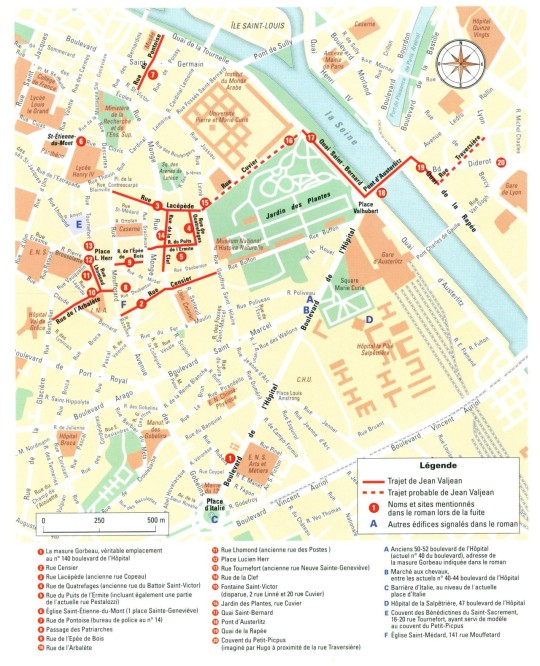
A quick overview: Jean Valjean starts in a slummy half-built suburban area. This area is highly associated with the King; the royal Jardin des Plantes is nearby, and King Louis XVIII often rides by in his carriage during the afternoons. After travelling down a bunch of streets, "zigzagging" back and forth, Jean Valjean decides to cross the Seine over the Bridge of Austerlitz (a bridge named after one of Napoleon's victories.) Then he reaches the areas of the city near the Faubourg Saint Antoine that are more associated with working class rebellion. From there he enters a dark isolated half-built medieval neighborhood near marshes and timberyards, with narrow mazey alleyways, that Hugo mostly made up. Hugo pretends this medieval neighborhood used to exist, but was destroyed like many others during the recent renovations. Now that we've gotten the overview out of the way, let's go more specific!
The chase starts out in "the old quarter of the Marche aux Chevaux." At the time, this was a less inhabited and poorer area of Paris; it's described as basically a slum. Here are some of Marville's photographs :

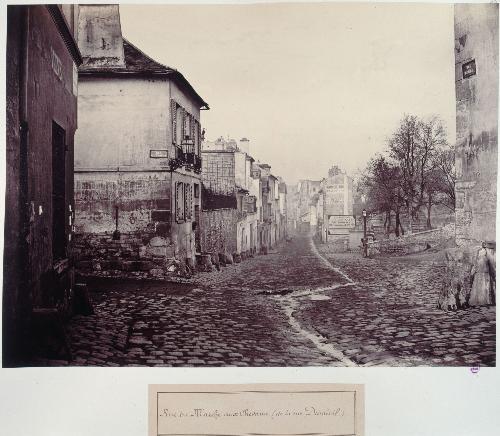
Then we're told "Jean Valjean described many and varied labyrinths in the Mouffetard quarter, which was already asleep, as though the discipline of the Middle Ages and the yoke of the curfew still existed. He combined in various manners, with cunning strategy, the Rue Censier:"
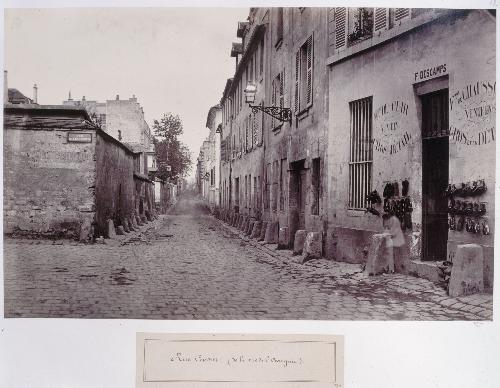
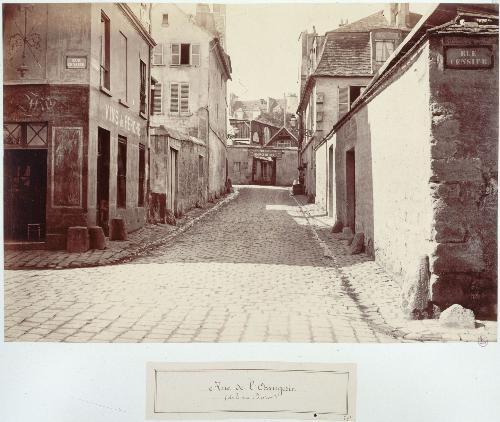


"and the Rue Copeau," (according to the map I linked earlier, the Rue Copeau is now the Rue Lacepede. Here is Marville's pic:)

"the Rue du Battoir-Saint-Victor and the Rue du Puits l’Ermite. There are lodging houses in this locality, but he did not even enter one, finding nothing which suited him. He had no doubt that if any one had chanced to be upon his track, they would have lost it."
"As eleven o’clock struck from Saint-Étienne-du-Mont:" (note: this refers to the church of Saint-Etienne)

"he was traversing the Rue de Pontoise, in front of the office of the commissary of police, situated at No. 14." (Jean Valjean sees Javert and the police following him on this street, because they're visible in the light of the lantern from the police station.)
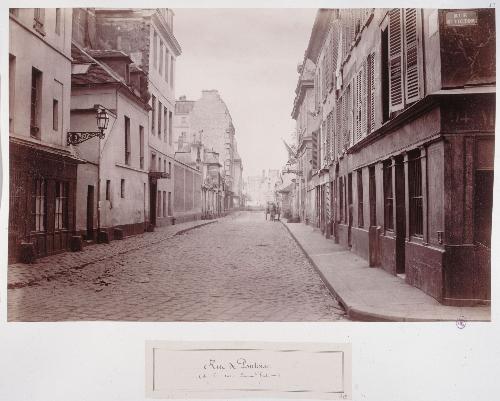
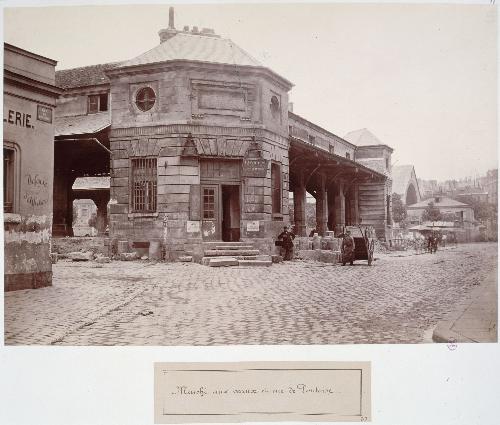
"He took a circuit, turned into the Passage des Patriarches, which was closed on account of the hour,"
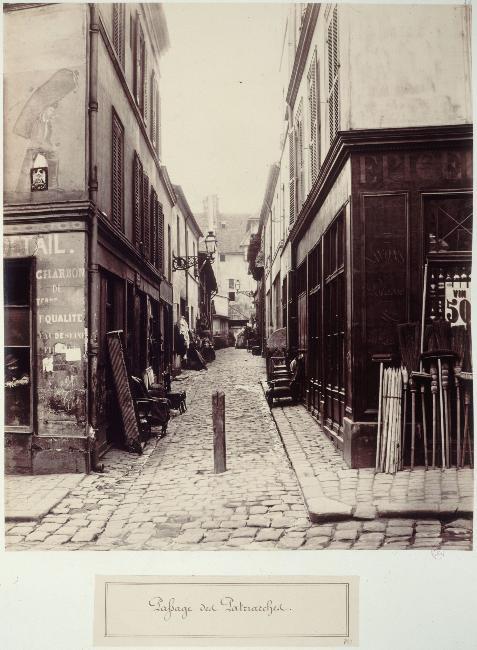
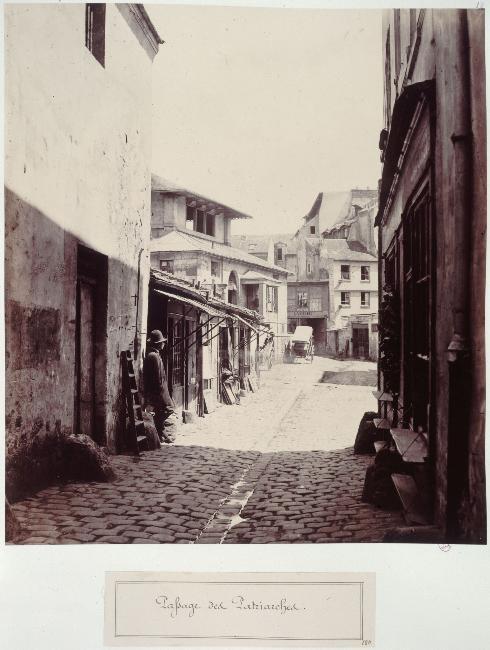
"strode along the Rue de l’Épée-de-Bois

and the Rue de l’Arbalète, and plunged into the Rue des Postes."




"At that time there was a square formed by the intersection of streets, where the College Rollin stands to-day, and where the Rue Neuve-Sainte-Geneviève turns off." (Note: these streets are labeled Montagne-Sainte-Geneviève, but not Neuve-Sainte-Geneviève, so they may be different streets! But I'm putting them here anyway.)
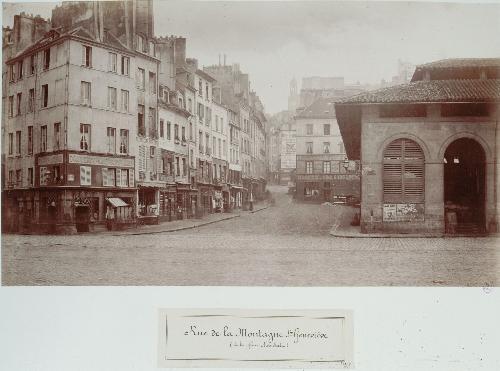


"It is understood, of course, that the Rue Neuve-Sainte-Geneviève is an old street, and that a posting-chaise does not pass through the Rue des Postes once in ten years. In the thirteenth century this Rue des Postes was inhabited by potters, and its real name is Rue des Pots." (Annotation: Hugo's bein silly and making little puns. He's snarkily pointing out the "new saint-genevieve street" is old, and the post street rarely has post-chaises/carriages go through it.)
(Jean Valjean hides in the shadows and watches to see who shows up in this big square intersection of streets. In the moonlight, he recognizes Javert.)
"He slipped from under the gate where he had concealed himself, and went down the Rue des Postes (which I shared a picture of previously), towards the region of the Jardin des Plantes." (Note: the Jardin des Plantes is a royal garden. Here is a modern photo from Wikipedia.)

"He left behind him the Rue de la Clef,

"then the Fountain Saint-Victor, skirted the Jardin des Plantes by the lower streets, and reached the quay. There he turned round. The quay was deserted. The streets were deserted. There was no one behind him. He drew a long breath.
He gained the Pont d’Austerlitz."
(The Pont d'Austerlitz, named after Napoleon's victory at the battle of Austerlitz, is a very famous bridge. Marville has no photographs but here's an 1830 engraving:)

"The bridge once crossed, he perceived some timber-yards on his right. He directed his course thither. In order to reach them, it was necessary to risk himself in a tolerably large unsheltered and illuminated space. He did not hesitate. Those who were on his track had evidently lost the scent, and Jean Valjean believed himself to be out of danger. Hunted, yes; followed, no."
Here's the quai by the pont-au-change-- a different quai, but gives you an idea of what the areas around the Seine often looked like.
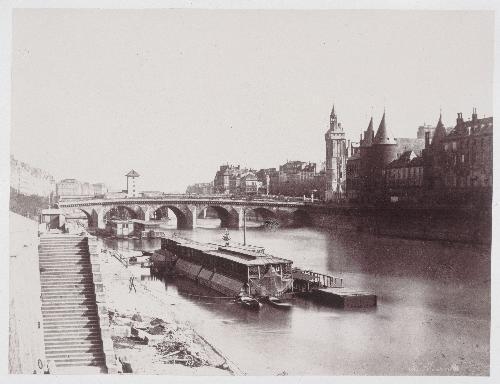
(Then Jean Valjean sees Javert and the other police on the Bridge of Austerlitz, following him. He hurries towards the darker alleys of the city.)
"A little street, the Rue du Chemin-Vert-Saint-Antoine, opened out between two timber-yards enclosed in walls. This street was dark and narrow and seemed made expressly for him."
Here's an abandoned timber-yard-ish looking picture:

But Marville has no photographs of this street. I'd have to double check, but iirc this is the part where Hugo starts to 'make up' more street layouts. I wouldn't be surprised if this street really WAS made expressly for him (meaning Hugo made it up.)
"The point of Paris where Jean Valjean found himself, situated between the Faubourg Saint-Antoine and la Râpée, is one of those which recent improvements have transformed from top to bottom,—resulting in disfigurement according to some, and in a transfiguration according to others. The market-gardens, the timber-yards, and the old buildings have been effaced. To-day, there are brand-new, wide streets, arenas, circuses, hippodromes, railway stations, and a prison, Mazas, there; progress, as the reader sees, with its antidote."
(Here Hugo talks about the Haussman renovations directly, claiming that if his street layouts are "inaccurate" it's because these are some of the Old Medieval Streets that were razed during Paris's recent renovations. He goes on for a while comparing Petit-Picpus to various other areas that were changed during the renovations.)
"Le Petit-Picpus, which, moreover, hardly ever had any existence, and never was more than the outline of a quarter, had nearly the monkish aspect of a Spanish town. The roads were not much paved; the streets were not much built up. (....) Such was this quarter in the last century. The Revolution snubbed it soundly. The republican government demolished and cut through it. Rubbish shoots were established there. Thirty years ago, this quarter was disappearing under the erasing process of new buildings. To-day, it has been utterly blotted out."
The Petit-Picpus, of which no existing plan has preserved a trace, is indicated with sufficient clearness in the plan of 1727, published at Paris by Denis Thierry, Rue Saint-Jacques, opposite the Rue du Plâtre;

and at Lyons, by Jean Girin, Rue Mercière, at the sign of Prudence.
Petit-Picpus had, as we have just mentioned, a Y of streets, formed by the Rue du Chemin-Vert-Saint-Antoine, which spread out in two branches, taking on the left the name of Little Picpus Street, and on the right the name of the Rue Polonceau. The two limbs of the Y were connected at the apex as by a bar; this bar was called Rue Droit-Mur.
The Rue Polonceau ended there; Rue Petit-Picpus passed on, and ascended towards the Lenoir market. A person coming from the Seine reached the extremity of the Rue Polonceau, and had on his right the Rue Droit-Mur, turning abruptly at a right angle, in front of him the wall of that street, and on his right a truncated prolongation of the Rue Droit-Mur, which had no issue and was called the Cul-de-Sac Genrot."
Here is @everyonewasabird's attempt to puzzle this out:

It was here that Jean Valjean stood."
Then Jean Valjean escapes by pulling down an old oil lantern, strung up by ropes. Hugo notes that this would have been "impossible if the streets were lit with gas, the way they would be after the renovations. This picture shows an old oil lamp strung up by ropes:

Finally, Jean Valjean climbs over the wall into the Petit-Picpus convent. This convent is fictional. Hugo pretends it used to exists but is no longer around-- another relic of the early 19th century that has been lost over time.
TLDR:
Jean Valjean's escape through Paris is Hugo way of mourning the Paris he knew from before his exile, the Paris before the modern renovations. To quote Volume 2 Book 5 Chapter 1:
The author of this book, who regrets the necessity of mentioning himself, has been absent from Paris for many years. Paris has been transformed since he quitted it. A new city has arisen, which is, after a fashion, unknown to him. There is no need for him to say that he loves Paris: Paris is his mind’s natal city. In consequence of demolitions and reconstructions, the Paris of his youth, that Paris which he bore away religiously in his memory, is now a Paris of days gone by. He must be permitted to speak of that Paris as though it still existed. It is possible that when the author conducts his readers to a spot and says, “In such a street there stands such and such a house,” neither street nor house will any longer exist in that locality. Readers may verify the facts if they care to take the trouble. For his own part, he is unacquainted with the new Paris, and he writes with the old Paris before his eyes in an illusion which is precious to him. It is a delight to him to dream that there still lingers behind him something of that which he beheld when he was in his own country, and that all has not vanished. So long as you go and come in your native land, you imagine that those streets are a matter of indifference to you; that those windows, those roofs, and those doors are nothing to you; that those walls are strangers to you; that those trees are merely the first encountered haphazard; that those houses, which you do not enter, are useless to you; that the pavements which you tread are merely stones. Later on, when you are no longer there, you perceive that the streets are dear to you; that you miss those roofs, those doors; and that those walls are necessary to you, those trees are well beloved by you; that you entered those houses which you never entered, every day, and that you have left a part of your heart, of your blood, of your soul, in those pavements. All those places which you no longer behold, which you may never behold again, perchance, and whose memory you have cherished, take on a melancholy charm, recur to your mind with the melancholy of an apparition, make the holy land visible to you, and are, so to speak, the very form of France, and you love them; and you call them up as they are, as they were, and you persist in this, and you will submit to no change: for you are attached to the figure of your fatherland as to the face of your mother.
99 notes
·
View notes
Text
"con artist" is maybe the profession with the biggest gap between How Cool They Are In Media and How Cool They Are In Real Life
21K notes
·
View notes
Note
Arnold Rimmer from Red Dwarf?

Please reblog for a larger sample size.
#no#canonically#but i think you could train him to be with positive reinforcement#plus he is a gay man who has only ever had sex with women so#red dwarf#arnold rimmer
56 notes
·
View notes
Text
People used to talk about blondes and brunettes like they were different genders
29K notes
·
View notes
Text
I don't know what paddington is doing on that list, but it made me think of the time someone drew a picture of the queen with paddington after she died, and we had scores of people losing their minds at the idea that paddington bear wasn't the same kind of communist as them
6K notes
·
View notes
Text

...........................................................
24K notes
·
View notes
Text
no matter how terrible my day is. i can always end my day in bed imagining fictional characters making out sloppy style and fucking raw. and that's beautiful. there's some good in this world mister frodo and it's worth fighting for
22K notes
·
View notes
Text
I love Matilda because it's a story about a child who sees injustice around her and gets mad about it and questions why things aren't fair, and instead of the ending being that she learns how the world works and that life isn't fair, she catapults one of the adults who abused her out of a building with her mind
79K notes
·
View notes
Text
"the 'power of love' trope is such an overused and cliche gimmick" i do not care i will love it always and forever. love prevails and explodes the enemy
44K notes
·
View notes
Text
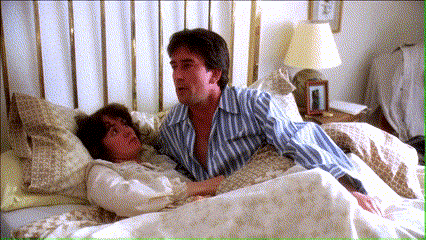




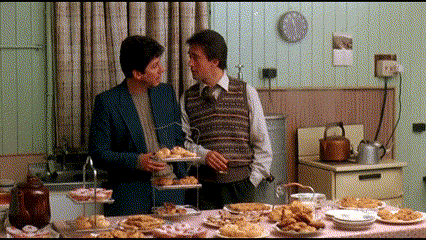




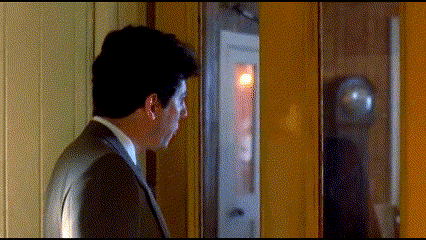

LOCAL HERO (1983) - dir. Bill Forsyth
You should say goodbye to Stella.
It doesn't matter.
Go and see her, Mac.
Say toodle-oo for me. And toodle-oo to you, too.
#movies of all time#local hero#they're so....#in my head they all moved together to glasgow and lived happily ever after#also the grey jumper Mac wears Changed Me
5 notes
·
View notes
Text
absolutely losing my mind that a bunch of nimby assholes spent $500k to build a sandcastle that was promptly wiped away
38K notes
·
View notes
Text
gonna make one of these for every season while i rewatch the show 😙
(tiktok muted this so you guys can have it🫶)
57 notes
·
View notes








